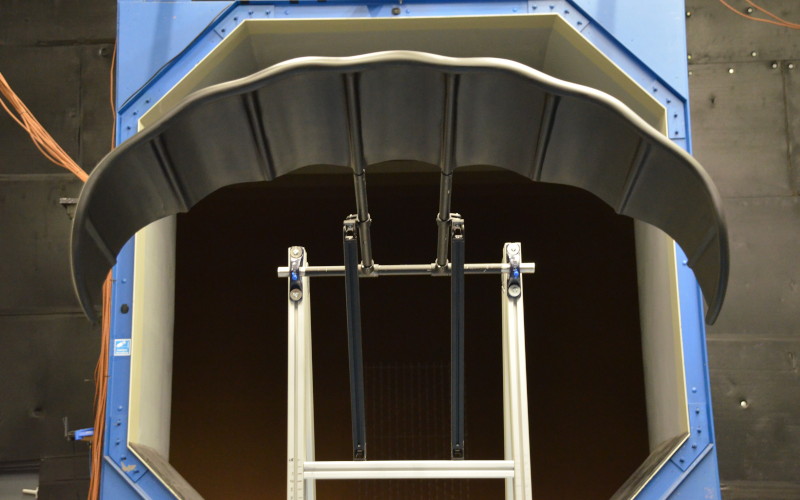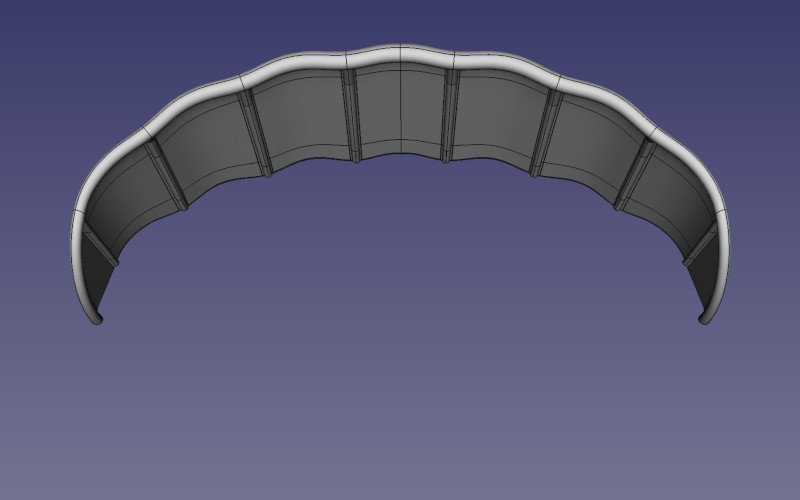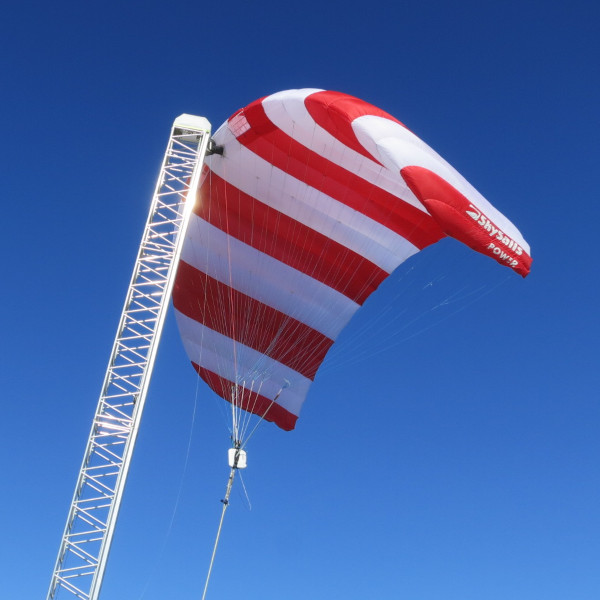Airborne Wind Energy
Basic mechanics of crosswind kites
Roland Schmehl
26 September 2025
Outline
- Definitions and assumptions
- Kite kinematics
- Kite aerodynamics
- Tethered flight
- Steady gliding flight
- Tethered static flight
- Ideal crosswind flight
- Radial flight
Learning objectives
- Derive a basic theory of tethered flight and energy harvesting with kites
- Identify all relevant problem parameters
- Introduce a consistent set of non-dimensional numbers
- Illustrate idealized flight scenarios practical examples
Relevant literature sources are Loyd (1980) and Diehl (2013).
Definitions and assumptions
Terminology
- Velocity is a vector property.
- Speed is a scalar property, the magnitude
of the velocity vector. - A kite can be of fixed-wing of soft-wing type.
Terminology
- Velocity is a vector property.
- Speed is a scalar property, the magnitude
of the velocity vector. - A kite can be of fixed-wing of soft-wing type.
Mathematical notation
- Scalars are set in italic: \(a\), \(b\), \(\rho\), \(\phi\)
- In digital resources, vectors are set in bold roman: \(\vec{v}\), \(\vec{L}\), \(\vec{D}\)
- In handwritten resources, vectors are overset with an arrow: \(\overset{→}{v}\), \(\overset{→}{L}\), \(\overset{→}{D}\)
- Units are set in roman: \(\rm m\), \(\rm kg\)
- Mathematical functions are set in roman: \(\sin\), \(\cos\), \(\max\)
- Product of scalars: \(a b\)
- Scalar product of vectors: \(\vec{v}\cdot\vec{v} = v^2\)
- Cross product of vectors: \(\vec{v} = \boldsymbol\omega\times\vec{r}\)
- Cartesian unit vectors: \(\vex\), \(\vey\), \(\vez\)
Environmental properties
Ambient wind velocity
\[\vvw, \quad {\rm m/s}\]
Air density
\[\rho, \quad {\rm kg/m}^3\]
Dynamic wind pressure
\[q = \frac{1}{2}\rho\vw^2, \quad {\rm
N/m}^2\]
Wind power density
\[\Pw = \frac{1}{2}\rho\vw^3, \quad {\rm
W/m}^2\]
Gravitational acceleration
\[\vec{g}, \quad {\rm m/s}^2\]
Kite properties
Flat wing surface area (unrolled)
Wing planform area (projected)
\[S, \quad {\rm m}^2\]
Wing span
\[b, \quad {\rm m}\]
Wing side area (projected)
Wing maximum chord
\[\cmax, \quad {\rm m}\]
Airfoil geometry
Kite mass¹
\[\mk, \quad {\rm kg}\]
1 Often also just denoted as \(m\), without subscript.
Example: TU Delft V3 kite
Kite kinematics
Friedl (2015)
Kite kinematics
Kite velocity
\[\vvk\]
Apparent wind velocity
\[\vva = \vvw - \vvk\]
Resultant aerodynamic force
\[\Fa = \frac{1}{2}\rho\CR S \vaexp{2}, \quad
\text{with} \quad \vaexp{2} = \vva\cdot\vva\]
Apparent wind velocity
Kite velocity
\[\vvk\]
Apparent wind velocity
\[\vva = \vvw - \vvk = \vvw + (-
\vvk)\]
Relative flow
Kite aerodynamics
Poland et al. (2025)
Aerodynamic forces
Resultant aerodynamic force can be decomposed into lift and drag
force
\[\vFa = \vec{L} + \vec{D}\]
Drag force component is defined as
\[\vec{D} \parallel \vva\]
Lift force component is defined as
\[\vec{L} \perp \vva\]
Aerodynamic side force \(\vFas \sim \betas\) neglected for performance modeling.
\[\begin{align} \vec{L} & = \frac{1}{2}\rho\CL S \vaexp{2}\\ \vec{D} & = \frac{1}{2}\rho\CD S \vaexp{2} \end{align}\]
Determining aerodynamic coefficients

Wind tunnel measurement
- Rigid scale model with 1.28 m span
- Unloaded design shape
- Variable angle of attack & side slip angle
- Reynolds number lower than real kite

Computational Fluid Dynamics
- CAD model before meshing
- Unloaded design shape
- Variable angle of attack & side slip angle
- Uncertainty about captured physics
Aerodynamic characteristics
- Data for TU Delft V3 kite with empirical corrections for different flight phases: powered, depowered, steered.
Aerodynamic lift devices
Airfoil
- Full range of \(L/D\)
- \(D\) can be minimised
- Control by angle of attack
Rotating cylinder
- Limited \(L/D\)
- \(D\) can not be modified
- Control by angular velocity
Tethered flight
- Aerodynamic forces
- Aerodynamic lift and drag
Approach
Start from the minimal
setup, the untethered wing.
Step by step add physical
components,
add motion components,
and compute forces acting on the system.
Analytic
modelling framework
\[\zeta = \frac{P}{\Pw S} =
\CR\left[1+\left(\frac{L}{D}\right)^2\right] f \left(\cos\beta\cos\phi -
f\right)^2\]
Steady gliding flight
TobiWanKenobi/Wikipedia
Stagnant wind
Kite velocity
\[\vvk = \vvkx + \vvkz = \const\]
Glide ratio
\[E = \frac{\vkx}{\vkz} =
\frac{1}{\tan\gamma} \quad ⤳ \quad \text{glide angle }
\gamma\]
Apparent wind
velocity
\[\vva = \vvw -\vvk = -\vvk, \quad
\text{with} \qquad \vw=0\]
Steady force
equilibrium
\[m\vg + \vFa = 0\]
Geometric similarity
of kinematic and force triangles because \(\vvkz \parallel \vFa\) and \(\vvk \parallel \vec{D}\)
\[E = \frac{\vkx}{\vkz} =
\frac{L}{D}\]
Geometric similarity
Same shape but different scale, in fact, different units (N vs m/s).
Uniform and constant wind
Effect of additional wind velocity \(\vw > 0\)
If wing flies against wind, glide angle \(\gamma\) gets steeper
Apparent wind
velocity
\[\begin{align}
\vva & = \vvw -\vvk\\
\vax & = \vw -\vkx \\
\vaz & = -\vkz
\end{align}\]
Geometric similarity
of kinematic and force triangles
\[E = \frac{\vax}{\vaz} =
\frac{L}{D}\]
Application in
AWE:
limiting case of retraction in pumping cycle with
vanishing tether tension.
Tethered static flight
Library of Congress / NPS.gov
Dan Tate, left, and Wilbur Wright, right, flying
the 1902 glider as a kite, on 19 September 1902.
Static massless kite
Kite velocity
\[\vvk = 0\]
Apparent wind
velocity
\[\vva = \vvw - \vvk =
\vvw\]
Static force
equilibrium
\[\vFt + \vFa = 0\]
\[\Ft = \Fa = \sqrt{L^2 + D^2}\]
\[\begin{align} \tan\beta & = \frac{L}{D} \\ \beta & = \arctan\frac{L}{D} \end{align}\]
\[\lim_{\frac{L}{D}⤳\infty} \beta = \frac{\pi}{2}\]
Effect of gravity
Static force equilibrium
\[\vFt + \vFa + m\vg = 0\]
\[\Ft = \sqrt{\left(L-mg\right)^2 + D^2}\]
\[\begin{align} \tan\beta & = \frac{L-mg}{D} \\ & = \frac{L}{D} \left[1-\frac{mg}{L}\right] \\ & = E\,\left[1-\frac{2gm}{\rho\CL S \vwexp2}\right] \end{align}\]
\[\begin{align} \phantom{\tan\beta} & = E\,\left[1-\frac{\color{red}{\frac{2g}{\rho\CL}\frac{m}{S}}}{\vwexp2}\right] \end{align}\]
But what is the physical meaning of \(\color{red}{\frac{2g}{\rho\CL}\frac{m}{S}}\)?
Static take-off limit

Generated lift just balances the effect of gravity:
\[\frac{1}{2}\rho\CL S
\vwexp2=mg\]
Equivalent to \(\beta = 0\) (horizontal tether).
Solving for \(\vw\) leads to static take-off wind
speed:
\[\vwsto =
\sqrt{\frac{2g}{\rho\CL}\frac{m}{S}}\]
Mass-to-area ratio \(m/S\) is an important scaling parameter affecting take-off limit
Definition identical to the stall speed \(\vstall\) of an aircraft (Anderson 2016).
Effect of gravity
Static force equilibrium
\[\vFt + \vFa + m\vg = 0\]
\[\Ft = \sqrt{\left(L-mg\right)^2 + D^2}\]
\[\begin{align} \tan\beta & = \frac{L-mg}{D} \\ & = \frac{L}{D} \left[1-\frac{mg}{L}\right] \\ & = E\,\left[1-\frac{2gm}{\rho\CL S \vwexp2}\right]\\ & = E\,\left[1-\frac{\color{red}{\frac{2g}{\rho\CL}\frac{m}{S}}}{\vwexp2}\right] \end{align}\]
\[\begin{align} \phantom{\tan\beta} & = E\,\left[1-\left(\frac{\color{red}{\vwsto}}{\vw}\right)^2\right], \quad \text{with} ~ \vwsto = \sqrt{\frac{2g}{\rho\CL}\frac{m}{S}} \end{align}\]
Static take-off wind speed
| Kite | \(S~\text{(m$^\text{2}$)}\) | \(m~\text{(kg)}\) | \(\CLmax~\text{(-)}\) | \(m/S~\text{(kg/m$^\text{2}$)}\) | \(\vwsto~\text{(m/s)}\) |
|---|---|---|---|---|---|
| Ampyx AP2 | 3 | 35 | 1.5 | 11.7 | 11.3 |
| Mozaero AP3 | 12 | 475 | 2.1 | 39.6 | 17.5 |
| Makani MX2 | 54 | 1850 | 2 | 34.3 | 16.7 |
| MegAWES | 150.45 | 6885 | 1.9 | 45.8 | 19.8 |
| TU Delft V3 | 19.75 | 22.8 | 0.88 | 1.15 | 4.6 |
| Kitepower V9 | 47 | 73 | 1.19 | 1.55 | 4.6 |
Source: Joshi et al. (2024)
Ideal crosswind flight
TU Delft V3 kite flying on launch mast in 2012
Massless crosswind kite
Reeling factor ⤳
degree of freedom
\[f = \frac{\vkx}{\vw}\]
Tangential velocity
factor
\[\lambda =
\frac{\vky}{\vw}\]
Apparent wind
velocity
\(\begin{aligned}
\vva & = \vvw - \vvk \\
& = \left( \vw - \vkx \right)\vex + \left( - \vky
\right)\vey
\end{aligned}\)
Geometric similarity
of velocity and force triangles
\[\frac{L}{D} = \frac{\vky}{\vw-\vkx} \qquad
⤳ \qquad \frac{L}{D}\left( \vw - \vkx \right) = \vky \\
\lambda = \frac{L}{D} \left( 1-f \right) = E \left( 1-f \right)
\quad \quad \text{dependent variable, i.e. not a degree of
freedom!}\]
Massless crosswind kite
Apparent wind velocity
\(\begin{aligned}
\vaexp{2} & = \left( \vw-\vkx \right)^2 + \vky^2 \qquad ⤳ \qquad
\left(\frac{\va}{\vw}\right)^2 = \left( 1-f \right)^2 + \lambda^2\\
\frac{\va}{\vw} & = \left( 1-f \right) \sqrt{1+E^2}
\end{aligned}\)
Aerodynamic
force
\[\Fa = \frac{1}{2}\rho S \CR \vaexp{2} =
\frac{1}{2}\rho S \CL \sqrt{1+\frac{1}{E^2}}
\left(\frac{\va}{\vw}\right)^2 \vwexp{2}\]
Non-dimensional tether
force
\[\frac{\Ft}{qS} = \CL \sqrt{1+\frac{1}{E^2}}
\left( 1-f \right)^2 \left( 1+E^2 \right), \quad \text{with} \qquad
q=\frac{1}{2}\rho\vwexp{2}\]
Power harvesting
factor
\[\zeta = \frac{P}{\Pw S} = C_L
\sqrt{1+\frac{1}{E^2}} f \left( 1-f \right)^2 \left( 1+E^2 \right),
\quad \text{with} \qquad \Pw =
\frac{1}{2}\rho\vwexp{3}\]
Optimal reel-out speed
Maximum power harvesting factor at maximum value of
\(f \left( 1-f \right)^2\)
This leads to a
condition for the first derivative
\[0 = \frac{\rm{d}}{\rm{df}} \left[ f \left(
1-f \right)^2 \right]\]
from which the optimal
reeling factor can be determined
\[\fopt=\frac{1}{3}\]
Optimal harvesting
factor using \(\fopt\)
\[\zetaopt = \frac{4}{27} C_L
\sqrt{1+\frac{1}{E^2}}\left( 1+E^2 \right)\]
Reality check
The analytic formula for \(\zetaopt\) is based on a number of idealizations:
- ideal crosswind operation at \(\beta=\phi=0\),
- neglected reel-in phase,
- vanishing mass of the airborne system components,
- dragless tether.
In reality, the achievable power harvesting factor is substantially lower than predicted by \(\zetaopt\).
Compare achievable power harvesting factor of the Kitepower Falcon:
- rated power of 100 kW at the rated wind speed of 10 m/s,
- optimal power harvesting factor \(\zetaopt=\) 11.36,
- achievable power harvesting factor \(\zeta=\) 3.47.
- This is about 30% of the theoretical optimum value.
Maximum reel-out factor?
- At \(f=1\) the apparent wind speed
vanishes
⤳ kite can not produce any lift. - But what happens for \(f>1~(\vt>\vw)\)?
⤳ gliding in downwind direction,
⤳ vanishing tether tension.
- Practical application is step towing,
by
alternating downwind gliding with \(f>1\), and
upwind retraction of the kite with \(f<0\). - Technique well known from winch
launching of paragliders.
Note: for \(\beta>0\) and/or \(\phi \ne 0\), \(\va\) vanishes for \(f<1\).
Crosswind kite with mass
Static force equilibrium
\[\vFt + \vL + \vD + m\vg = 0\]
Horizontal lift force
component
\[|\vec{L} + m\vec{g}| = \sqrt{L^2 -
\left(mg\right)^2}\]
Geometric
similarity
\[\frac{\vky}{\vw-\vkx} = \frac{\sqrt{L^2 -
\left(mg\right)^2}}{D}\]
Tangential velocity
factor
\[\lambda = (1-f)E\sqrt{1 - \left(
\frac{mg}{L} \right)^2}\]
2025-04-10-resit
Crosswind kite with mass
Apparent wind speed
\[\begin{align}
\left( \frac{\va}{\vw} \right)^2 & = (1-f)^2 + \lambda^2 \\
& = \left( 1 - f \right)^2 \left\{
1 + E^2\left[ 1-\left(\frac{mg}{L}\right)^2 \right] \right\} \\
& = \left( 1 - f \right)^2 \left\{
1 + E^2\left[
1-\left(\frac{\frac{2g}{\rho\CL}\frac{m}{S}}{\vaexp{2}}\right)^2 \right]
\right\}
\end{align}\]
Substitute
\[\color{red}{x} = \left( \frac{\va}{\vw}
\right)^2\quad ⤳\]
\[\color{red}{x} = \left( 1 - f \right)^2 \left\{ 1 + E^2\left[ 1-\left(\frac{\vwsto}{\vw}\right)^4 \frac{1}{\color{red}{x^2}}\right]\right\}\]
2025-04-10-resit
Crosswind kite with mass
\[\color{red}{x} = \left( 1 - f \right)^2 \left\{ 1 + E^2 - E^2\left(\frac{\vwsto}{\vw}\right)^4 \frac{1}{\color{red}{x^2}}\right\}\]
Cubic equation, with missing linear term
\[\color{red}{x^3} - \left( 1 - f \right)^2
\left( 1 + E^2 \right) \color{red}{x^2} + \left( 1 - f \right)^2 E^2
\left(\frac{\vwsto}{\vw}\right)^4 = 0\]
Cubic equation in standard form
\[a x^3 + b x^2 + c x + d = 0, \quad
\text{with}\]
\[\begin{align} a & = 1, \\ b & = - \left( 1 - f \right)^2 \left( 1 + E^2 \right), \\ c & = 0, \\[-15px] d & = \left( 1 - f \right)^2 E^2 \left(\frac{\vwsto}{\vw}\right)^4. \\ \end{align}\]
2025-04-10-resit
Number and nature of roots
A cubic equation has three roots. The nature of the three roots
depends on the value of the discriminant
\[
\begin{align*}
\Delta & = \ccancel{18 abcd} - 4b^3d + \ccancel{b^2c^2} -
\ccancel{4ac^3} - 27 a^2d^2 \fragment{0}{, \quad \text{because} \quad
\color{red}{c=0}} \\
& \fragment{1}{{} = 4(1-f)^8(1+E^2)^3 E^2 \left(
\frac{\vwsto}{\vw} \right)^4 - 27(1-f)^4 E^4 \left( \frac{\vwsto}{\vw}
\right)^8,} \\
& \fragment{2}{{} = (1-f)^4 E^2 \left( \frac{\vwsto}{\vw}
\right)^4 \left[ 4 (1-f)^4 (1+E^2)^3 - 27 E^2 \left( \frac{\vwsto}{\vw}
\right)^4 \right]}
\end{align*}
\]
For \(\Delta < 0\), the equation has one real root and two non-real complex conjugate roots.
For \(\Delta = 0\), the equation has one real root and two real repeated roots.
For \(\Delta > 0\), the equation has three distinct real roots.
Cubic polynomial
Polynomial function and derivatives
\[\begin{alignat*}{2}
&p(x) &&= x^3 - \left( 1 - f \right)^2 \left( 1 + E^2
\right) x^2 + \left( 1 - f \right)^2 E^2
\left(\frac{\vwsto}{\vw}\right)^4, \\[-6mm]
&p'(x) &&= 3x^2 - 2\left( 1 - f \right)^2 \left( 1 +
E^2 \right) x, \\
&p''(x) &&= 6x - 2\left( 1 - f \right)^2 \left( 1 +
E^2 \right).
\end{alignat*}\]
⤳ Wind speed \(\vw\) affects vertical offset of polynomial
End behavior
\[\begin{alignat*}{3}
&x\to & -\infty &⤳ p(x)\to & ~ -\infty, \\
&x\to & \infty &⤳ p(x)\to & ~ \infty.
\end{alignat*}\]
Critical points: local
extrema \((p'=0)\)
\[\begin{alignat*}{4}
&x &&
=0 &&⤳
\text{local maximum} && (p'' < 0). \\
&\xc && =\frac{2}{3} \left( 1 - f \right)^2 \left( 1 + E^2
\right) &&⤳ \text{local minimum} \quad && (p''
> 0).
\end{alignat*}\]
Polynomials for the TU Delft V3 kite at \(f=0\).
Physical solution space
\(x \ge \xmin = (1-f)^2.\)
This lower limit follows from the definition of the
non-dimensional apparent wind speed as
\[x = (1-f)^2+\lambda^2,\]
and the fact that the crosswind contribution is always positive, i.e. \(\lambda^2 \ge 0\).
\(x \le \xmax = \left( 1 - f \right)^2 \left( 1 + E^2 \right).\)
This upper limit is the apparent wind speed for Loyd’s ideal crosswind case, where \(m=0\).
Interesting is also the observation
\[\xc = \frac{2}{3} \xmax.\]
Polynomials for the TU Delft V3 kite at \(f=0\).
Minimum flyable wind speed
- At \(\vw=\frac{1}{4}\vwsto\), the cubic equation has no real roots in the physical solution space.
- At \(\vw=\frac{1}{3}\vwsto\), the cubic equation has two real roots in the physical solution space.
- At what value of \(\vw\) does the cubic equation have a repeated real root, transitioning from no real root to two real roots?
- This transition is described mathematically by the discrimonant \(\Delta\) changing the sign from negative to positive.
Polynomials for the TU Delft V3 kite at \(f=0\).
Discriminant
The discriminant is positive when
\[
\begin{align*}
4 (1-f)^4 (1+E^2)^3 & > 27 E^2 \left(
\frac{\vwsto}{\vw} \right)^4, & & \\
\fragment{0}{{}\left( \frac{\vw}{\vwsto} \right)^4} &
\fragment{0}{{} > \frac{27 E^2}{4 (1-f)^4 (1+E^2)^3},} & & \\
\fragment{1}{{}\vw} &
\fragment{1}{{} > \sqrt[\Large 4]{\frac{27 E^2}{4(1+E^2)^3}}
\frac{\vwsto}{1-f},} & \\
\fragment{2}{{}\vw} &
\fragment{2}{{} > \frac{\vwc}{1-f}, \quad \text{with} \quad}
&
\fragment{2}{{} \vwc } & \fragment{2}{{} = \sqrt[\Large 4]{\frac{27
E^2}{4(1+E^2)^3}}\, \vwsto, \quad \text{and}} \\
& &
\fragment{2}{{} \vwsto} & \fragment{2}{{} =
\sqrt{\frac{2g}{\rho\CL}\frac{m}{S}}.}
\end{align*}
\]
But what is the physical meaning of \(\vwc\)?
Cardano’s method
Cubic polynomial
Polynomial for \(f=0\) and physical parameters of the TU Delft V3 kite
Investigate the cubic polynomial for
three different wind speeds,
\(\vw=\) \(0.9\vwc\), \(\vwc\) and \(1.1\vwc\).
By definition \(x = \left( \frac{\va}{\vw} \right)^2 \ge
0\),
⤳ \(x<0\) unphysical.
For \(\vw<\vwc\) \((\Delta < 0)\),
⤳ none of the real roots in
physical range.
For \(\vw=\vwc\) \((\Delta = 0)\),
⤳ repeated real root.
For \(\vw>\vwc\) \((\Delta > 0)\).
⤳ two distinct real roots.
Only interested in the lower value.
Full wind speed range
Tangential velocity factor \(\lambda_\mathrm{max} = \lambda(m=0)= E\).
Interpretation
Considering a kite with a static take-off wind
speed
\[\vwsto =
\sqrt{\frac{2g}{\rho\CL}\frac{m}{S}},\]
the theoretical cut-in wind speed for crosswind
operation at \(\beta=\phi=0\) is given
by
\[\vwc = \sqrt[\Large 4]{\frac{27
E^2}{4(1+E^2)^3}}\, \vwsto.\]
- This definition of a lower wind speed limit implies a constant tether length (\(f=0\)).
- For \(\vw < \vwc\), the kite can not generate a sufficient lift force for sustained flight.
- For \(\vwc < \vw < \vwsto\), the generated lift force can counteract gravity. In this wind speed regime, the tangential velocity factor \(\lambda\) is a function of the wind speed \(\vw\).
- For \(\vw > \vwsto\), the generated lift force is too high, driving the kite to a force equilibrium at higher elevation angles \(\beta\), or requiring reeling out (\(f>0\)).
Interpretation
- By reeling in (\(f<0\)), the flyable wind speed range can be temporarily decreased below the value of \(\vwc\), however, this condition can not be maintained for longer time.
- This low wind speed regime is particularly important for dynamic launching of kites.
- While the static take-off wind speed \(\vwsto\) is affected by the lift coefficient \(\CL\), the theoretical cut-in wind speed \(\vwc\) adds the dependence on the lift to drag ratio \(E\).
- Static take-off wind speed is affected by mass scaling, predominantly via the ratio \(m/S\).
- Theoretical cut-in wind speed is substantially lower, especially for kites with high aerodynamic performance \(E=L/D\).
- The analysis is highly idealized and the real cut-in wind speed of the kite will be higher.
Radial flight
Massless radial kite
Reeling factor ⤳
degree of freedom
\[f = \frac{\vk}{\vw}\]
Apparent wind
velocity
\[\vva = \vvw - \vvk\]
Decomposition of kite
velocity
\[\vvk = \vec{b} + \vec{c}\]
\[\vva = \vvw - \vec{b} - \vec{c}\]
\[\vvw = \vva + \vec{c} + \vec{b}\]
\[\vw^2 = \left( \va - c \right)^2 + b^2\quad
\text{(positive vector magnitudes!)}\] \[\frac{\va}{\vw} =
\sqrt{1-\left(\frac{b}{\vw}\right)^2} +
\frac{c}{\vw}\]
Displayed is the case for reel in with \(f<0\)
Massless radial kite
Geometric similarity
\[\frac{b}{\vk} = \frac{L}{\Fa} =
\frac{1}{\sqrt{1+\frac{1}{E^2}}}\] \[\frac{c}{\vk} = \frac{D}{\Fa} =
\frac{1}{\sqrt{1+E^2}}\]
Normalized to the wind speed
\[\frac{b}{\vw} =
-\frac{f}{\sqrt{1+\frac{1}{E^2}}}\] \[\frac{c}{\vw} =
-\frac{f}{\sqrt{1+E^2}}\]
Minus signs aacount for negative value of \(f\)
Displayed is the case for reel in with \(f<0\)
Massless radial kite
Apparent wind speed
\[\begin{align}
\frac{\va}{\vw} & = \sqrt{1 - \frac{f^2}{1 + \frac{1}{E^2}}} -
\frac{f}{\sqrt{1 + E^2}}, \\
& = \frac{\sqrt{1 + E^2\left( 1 - f^2 \right)} -
f}{\sqrt{1 + E^2}}
\end{align}\]
Non-dimensional tether force
\[\frac{\Ft}{qS} = \CL
\frac{\left[\sqrt{1+E^2(1-f^2)}-f\right]^2}{E\sqrt{1+E^2}}\]
Power harvesting factor
\[\zeta = \CL
\frac{f\left[\sqrt{1+E^2(1-f^2)}-f\right]^2}{E\sqrt{1+E^2}}\]
Displayed is the case for reel in with \(f<0\)
Massless radial kite
Elevation angle ⤳ not a degree of freedom
\[\cos\beta =
\frac{\sqrt{1+E^2(1-f^2)}+fE^2}{1+E^2}\]
Homework #1: Derive this expression.
Hint:
- Formulate two different expressions for the apparent wind speed, one of them containing \(\cos\beta\).
- Eliminate the apparent wind speed by equating those equations.
- Solve for \(\cos\beta\).
2022-04-06-resit 2(d)
Massless radial kite
Minimum reeling factor
\[f_{\rm
min}=-\sqrt{1+\frac{1}{E^2}}\]
Homework #2:
Derive this expression.
Hint:
- Use the fact that the radicant in the expression for \(\cos\beta\) has to be greater or equal to zero.
2022-04-06-resit 2(f)
Loyd’s theory - comparison
How to use these analytic models?
The wind speed \(\vw\) describes the available energy
resource.
The lift-to-drag ratio \(E\) characterizes the specific kite
design.
For the ideal crosswind kite prescribe
the tether reeling speed \(\vt\) to calculate the achievable kite
crosswind speed \(\vkx\),
or
the kite crosswind speed \(\vkx\) to calculate the required tether
reeling speed \(\vt\).
For the non-maneuvering kite prescribe
the tether reeling speed \(\vt\) to calculate the achievable elevation
angle \(\beta\), or
the elevation angle \(\beta\) to calculate the required tether
reeling speed \(\vt\).